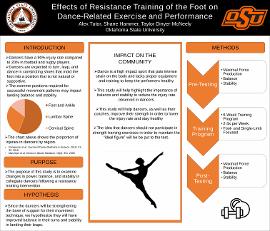| dc.contributor.advisor | Dinyer-McNeely, Taylor | |
| dc.contributor.author | Tutor, Alex | |
| dc.contributor.author | Hammer, Shane | |
| dc.date.accessioned | 2023-04-11T14:30:00Z | |
| dc.date.available | 2023-04-11T14:30:00Z | |
| dc.date.issued | 2023-04-18 | |
| dc.identifier | oksd_URS_2023_tutor | |
| dc.identifier.citation | Tutor, A., Hammer, S., & Dinyer-McNeely, T. (2023, April 18). Effects of resistance training of the foot on dance-related exercise and performance. Poster session presented at the Oklahoma State University Undergraduate Research Symposium, Stillwater, OK. | |
| dc.identifier.uri | https://hdl.handle.net/11244/337346 | |
| dc.description.abstract | The injury rate in dancers is higher than their mainstream counterparts, as dancers have a 90% injury rate compared to a 20% rate observed in rugby and football athletes. Even so, preventative equipment or techniques, such as braces or taping to keep the rate of injury down are less available to dancers to maintain the aesthetic appeal of the sport. Specifically, dancers are expected to perform barefoot or in tight shoes that reduce the ability of the foot to move freely, leading to injuries and disorders from high impact landings that cause the dancer to stop performing. This shocking injury rate and lack of preventative equipment is why it is important for dancers to engage in muscle strengthening exercises to reduce injury and improve performance. The high impact nature of the sport calls for training interventions that focus on the feet in order to provide stability during dance movements and maintain the aesthetics for performance. Therefore, the purpose of this study is to improve balance and force production during dance-related movements following a resistance training protocol. We will recruit 12 dancers to complete a 6-week resistance training intervention consisting of resistance band, single-leg, and rehabilitation exercises that are completed 3 times per week. Prior to the start of and immediately following the resistance training program, the dancers will come to the lab to complete pre- and post-testing measures. For pre- and post-training measures, the dancers will perform a series of tests to examine balance and stability, landing force following a leap, and maximal isometric force production of the foot musculature. These tests are designed to determine the effects of resistance training on variables associated with dance performance. Statistical analyses (p≤0.05) will include paired samples t-tests to examine changes in balance, leap force, and maximal isometric force production following the 6-week resistance training protocol. Due to the limited research available in dancers, the results from this study will provide pertinent information about preventative techniques dancers can implement to improve dance-related movements. | |
| dc.format | application/pdf | |
| dc.language | en_US | |
| dc.publisher | Oklahoma State University | |
| dc.rights | In the Oklahoma State University Library's institutional repository this paper is made available through the open access principles and the terms of agreement/consent between the author(s) and the publisher. The permission policy on the use, reproduction or distribution of the article falls under fair use for educational, scholarship, and research purposes. Contact Digital Resources and Discovery Services at lib-dls@okstate.edu or 405-744-9161 for further information. | |
| dc.title | Effects of resistance training of the foot on dance-related exercise and performance | |
| osu.filename | oksd_URS_2023_tutor.pdf | |
| dc.description.department | Kinesiology, Applied Health and Recreation | |
| dc.type.genre | Poster | |
| dc.type.material | Text | |
| dc.type.material | Image | |
| dc.subject.keywords | dance | |
| dc.subject.keywords | strength training | |
| dc.subject.keywords | stability | |
| dc.subject.keywords | power | |
